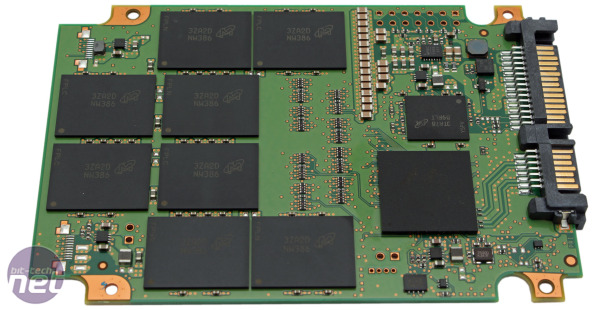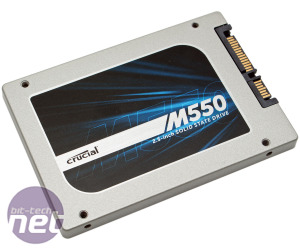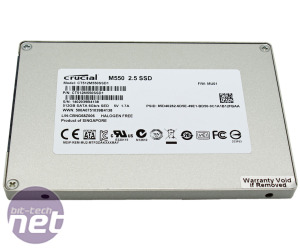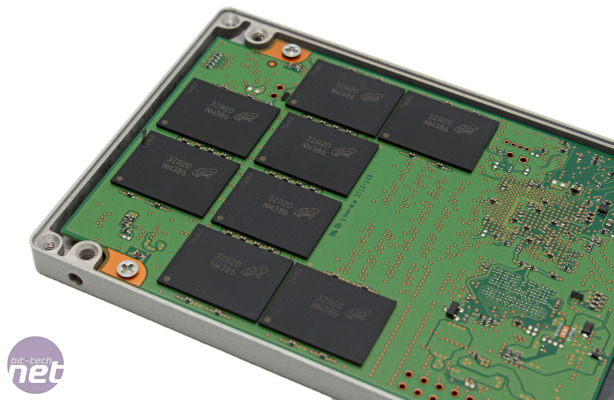Crucial M550 SSD 512GB Review
Manufacturer: CrucialUK price (as reviewed): MSRP £241.50 (inc VAT)
US price (as reviewed): MSRP $336.99 (ex Tax)
When we looked at the Crucial M500 we found it to be a decent SSD with a host of handy features rarely found in consumer drives, though its performance wasn't chart topping. Just six months ago its price was £270, which was pretty affordable for a 480GB drive. Now, however, it can be found for just £170 – a fantastic price no doubt, but one which may have something to do with today's launch of the M550 SSD. The new 512GB drive has a suggested retail price of £240, but naturally it may be lower than this at retailers. For reference, the SSD 840 Evo 500GB is as low as £200 now, but more professional 512GB drives are closer to £300.
As with the M500, the M550 will be available in mSATA and M.2 form factors with no performance deficit, though the 1TB drive is reserved for the standard 2.5-inch form factor. The 7mm tall drive comes with a spacer for 9mm bays, with no other accessories or software provided.
READ MORE: SSD and HDD Reviews
As you can see, the 512GB drive along with the 1TB one has the best performance of the range. Over the 480GB M500, sequential read and write speeds are up by 50MB/sec and 100MB/sec, while random read and write speeds (at 32 queue-depth) have increased by 15,000 and 5,000 IOPS respectively.
| Crucial M550 | 128GB | 256GB | 512GB | 1TB |
| Max Sequential Read | 550MB/sec | 550MB/sec | 550MB/sec | 550MB/sec |
| Max Sequential Write | 350MB/sec | 500MB/sec | 500MB/sec | 500MB/sec |
| Max Random Read (4K QD32) | 90,000 IOPS | 90,000 IOPS | 95,000 IOPS | 95,000 IOPS |
| Max Random Write (4K QD32) | 75,000 IOPS | 80,000 IOPS | 85,000 IOPS | 85,000 IOPS |
The M550 is again powered by a Marvell controller running custom firmware, though it's been upgraded from the 88SS9187 to the 88SS9189. Information on the eight-channel 9189 controller is scarce, but according to Crucial it has more bandwidth and allows for better programming efficiency, both of which contribute to the increased performance. It also now supports low-power DRAM, and indeed the 512MB cache is now of the LP-DDR3 variety, so it consumes less power than before and also happens to be a bit faster too. As with the M500, DEVSLP is also supported, with Crucial reporting that its drive typically consumes just 3mW in this ultra low power state, which is particularly beneficial to portable users and in stark contrast to Intel's latest SSDs, for instance.
As well as standard ATA AES 256-bit encryption support, the M550 also meets the TCG Opal 2.0 and IEEE-1667 standards of hardware level encryption. This means the drive again meets Microsoft's eDrive protocol, and the encryption is more secure and has less of a performance penalty than the ATA method, which also requires a password to be set within the BIOS in order to work.
Adaptive Thermal Protection, which automatically throttles performance when the drive detects that it has risen too far above its rated operating temperature (0°C – 70°C), is again present. At 78°C, write speeds fall to around 150MB/sec, and will continue to fall if temperatures continue to rise, with read speeds affected too. DRAM refresh rates are simultaneously increased to provide additional data integrity, and the drive will remain throttled until it reaches 65°C again. While unlikely to be an issue for desktop users, high performance gaming notebooks may be at risk of exceeding the operating temperatures, though a thermal pad connects the controller and cache to the SSD's metal chassis to aid cooling.
As you'd expect, the M550 uses Micron NAND, specifically the IMFT 20nm MLC variety, which is the same as that in the M500. In the higher capacities, 128Gbit dies are used, and in the 512GB model there are two of these in each of the sixteen NAND packages, and four per controller channel. 64Gbit dies are used in the 128GB and 256GB models to increase the number of dies per channel and thus increase performance. In terms of endurance, the M550 is again rated for around 40GB/day of host writes for five years (72TB total), and it carries the same three year limited warranty.
The move from rounded capacities (480GB) to power-of-two ones (512GB) equates to an increase in available capacity. This usually decreases performance and endurance, but with the M550 this isn't the case since the additional spare area in the M500 was used exclusively for RAIN (Redundant Array of Independent NAND), another feature carried over from Micron's enterprise business. Essentially, as user data is written, the M550 calculates and writes parity data to the NAND with a minimal performance penalty. This parity data block can then be used by the RAIN algorithms to restore the user data associated with it in the event of an unrecoverable error. In this sense it's similar to the distributed parity of a RAID 5 array.

Click to enlarge - The front of the PCB is home to the controller and cache as well as the capacitors that protect the drive against power failure
The reason that the M550 has more usable capacity is simply because the ratio of data to parity blocks has increased from 15:1 to 127:1, so there are now more data elements associated with each parity element. This ratio is fixed and cannot be altered. While the lowered parity technically means less reliability, Crucial says that the maturation of its 20nm NAND manufacturing process means that the drive still meets the same reliability targets, while the M500 with its lower ratio is now considered reliable enough to be used in certain data centre applications (which far exceed the endurance requirements of personal storage).
The final feature of note is the M550's power loss protection. Only 2-4MB of user data is ever stored in the large cache at one time (the rest is used to manage the NAND address table). In the event of sudden power loss, the series of capacitors on the PCB should power the drive long enough for this data to be flushed to NAND. Intel uses a similar method in its SSD 730 and the feature was also present in the M500.
Specifications
Interface: SATA 6GbpsNominal capacity: 512GB
Formatted capacity: 476.94GB
Controller: Marvell 88SS9189
Cache: 512MB LP-DDR2
Memory type/amount: 32 x 128Gbit IMFT 20nm MLC NAND dies (16 x 32GB packages)
Endurance rating: ~40GB/day for five years (72TB total)
Warranty: Three years

MSI MPG Velox 100R Chassis Review
October 14 2021 | 15:04












Want to comment? Please log in.